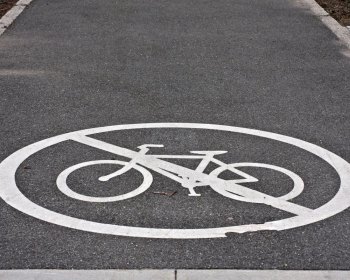Bicycle commuters encounter obstacles

But consider that while 7 percent of Europeans commute by bicycle, Americans, who tend to live farther from work, are much less likely to do so. For the 50 largest U.S. cities, the combined rate of bicycle commuting was just 1 percent during the 2008-2012 period, the Census report said, and that actually represents an increase from 0.6 percent in 2000.
So who are these people? First, they are more likely to be men. The rate of bicycle commuting for men -- 0.8 percent -- is more than double that for women, 0.3 percent, according to the Census Bureau.
Bicycle commuters are also likely to be educated. The rate of bicycle commuting is 0.9 percent for workers with graduate or professional-evel degrees. Ironically, the second most likely bicycle commuter has no high school diploma.
Everyone else goes to work on foot, by bus, by train or, commonly, by car. So why don’t more workers opt to take a bicycle to work?
- Love vs. Logistics: Perhaps Americans are still having a love affair with their cars. Or perhaps there is something else going on, according to the 2013 Status of the Nation's Highways, Bridges and Transit, a report by the U.S. Transportation Department. "Americans’ often cited 'love affair' with their cars may have much more to do with the design of our neighborhoods and land use decisions than with transportation," the report says. "Higher-density areas can provide more opportunities for walking, biking, and transit use than low-density areas. In some low-density neighborhoods, transit services are not cost-effective to provide and there are few destinations, such as schools, jobs or shopping, within walking distance. People may be left with no other choice but to drive." New York, parts of the Washington, D.C., area, and Portland, Oregon, are bicycle friendly. Indeed, Portland has the highest bicycle commuting rate among big cities (6.1 percent), according to the Census Bureau.
- The Details: The time U.S. commuters must spend traveling has an impact on other obligations, such as parenting and grocery shopping. Availability of showers and dressing facilities at work may also be factors. Some workers need a vehicle once at work.
To know more:
The Federal Highway Administration publishes Road Safety Audit guidelines. Recommendations include specific dimensions for cycling lanes and other measurable features involving bicycle traffic. A similar European publication, Raising the Bar; Review of Cycling Safety Policies in the European Union, provides recommendations based on road conditions throughout Europe.
The League of American Bicyclists was formed in 1880 to promote road improvement – namely paving. Since that time, the organization has continued to advocate for infrastructure issues that effect cyclists.
The Alliance for Biking and Walking partners with the League of American Bicyclists to support cycle-lobbying efforts. Other organizations that work on behalf of cyclists include People for Bikes (formerly Bikes Belong), The National Bicycle Greenway and CyclingSavvy.
Related:
After bicycling crash, author rethinks commute

